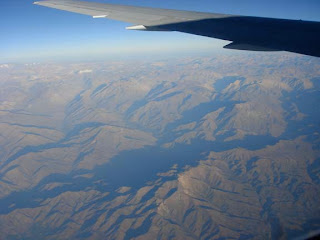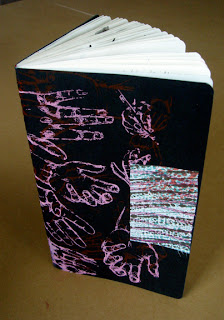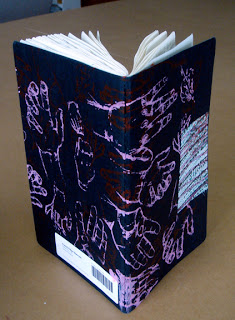 |
| Tim Harding's Exhibit at the Nash Gallery |
In June, I had the opportunity to attend Confluence, the biennial International Conference of the
Surface Design Association. As an SDA Board member, I knew that my tasks at the Conference went beyond mere participation, —I am in charge of all the "state" or Area Representatives — but I had a
wonderful time. What I've always appreciated about the SDA Conferences is that they provide not only a forum for networking and sharing of technical information, but they are also a rich snapshot of what's currently interesting in fiber art. Not all fiber art gets covered, of course, but participants on all levels of expertise return home with food for thought on many levels.
 |
| one third of the Members' Show, Merge & Flow, sandwiched between other stellar exhibits at the Nash Gallery |
|
Add to that, participants have the opportunity to see more than thirty exhibitions of contemporary fiber art, which alone would make the conference worth attending. Other events included a stellar fashion show of members' work, dynamic speakers and demonstrations, a members' trunk show, a vendor fair, regional members' meetings, and special interest gatherings, for example, for educators or batik artists. The beginning of the light rail expansion directly in front of the hotel caused some traffic complications in being able to see all the exhibitions, but most participants did go with the "merge and flow" and used the time to get to know one another.
 |
| members' meet & greet started our day of Gallery hopping |
|
|
Now in its 36th year, SDA came to pass in the time when local and national craft organizations were encouraged to add the work "design" or "designer" to their names in order to distinguish the kinds of work their artists did from folk and hobby craft. The Surface Design Association was born. Despite its longevity and history, the phrase "surface design" still causes some confusion. Here's how it is defined on SDA's
new website:
Surface Design refers to any process that gives structure, pattern, or color to fiber & fabric. These include spinning, felting, papermaking, weaving, knotting, netting, looping, dyeing, painting, stitching, cutting, piecing, printing, quilting, & embellishing.
And here's something about the organization:
The Surface Design Association is an international community engaged in the creative exploration of fiber & fabric. Our mission is to promote awareness & appreciation of the textile arts. Through member-supported publications, exhibitions & conferences, we inspire creativity, encourage innovation, & advocate excellence.
Confluence is co-sponsored by the
Textile Center of Minnesota. Director Margaret Miller tells us that the Center is comprised of 900 members in 35 member organizations. Now located in what was once a car dealership, the Center contains meeting rooms, gallery areas, a sales shop, a 23,000 volume library, and a well-equipped dye kitchen.
What follows is literally a snapshot my own personal view on the conference. It is not complete, but it reflects my experience and available photos. The exhibits appear in the next post.
Bodies of Water Fashion Show, Trunk Show, workshop photos and member pictures appear here. What's missing? All of the provocative speakers, like India Flint, Pat Hickman, Barbara Lee Smith, Stephen Fraser, Faythe Levine, Natalie Chanin and Jane Dunnewold, plus a wide array of panels and demos. And, all that camaradie, hard to capture. You just had to be there...
 |
| Awards Judges Leesa Hubbell and Lynne Pollard examine Penny Collins' Gown for Great Pacific Garbage Patch Ball, made of recycled plastic bags and winner of the SDA Award of Excellence |
 |
| examining the Fashion Show entries |
 |
| talking with Fashion Show Coordinator Anna Lee |
|
 |
| Chunghie Lee's Pojagi-making demonstration |
 |
| At the DIY fair: altering a T-shirt, fundraiser for the Textile Center of MN (above), TCM lacemaking demo, plus impromptu "fashion show parade" by 17 year-old fashion designer, shown in black suit & glasses (below) |
 |
| Trunk show & Vendors' Fair, above and below |
 |
| Faythe Levine discusses Handmade Nation, which was also shown |
 |
| international conferees viewing a beaded piece while waiting for Conference buses | | |
|
 |
one conferee on her way to the Fashion Show finishes the crocheted embellishment on her altered SDA T-shirt
|
|
|
 |
| SDA President Candace Edgerly with new American Crafts Council Executive Director Chris Admundsen. The ACC recently moved to Minneapolis from New York City, |
























































